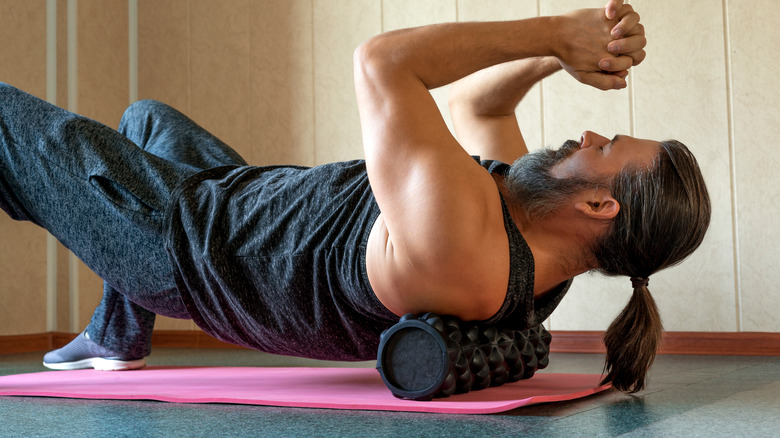The Best Exercises For Thoracic Back Pain
When it comes to back pain, any pain along the spine can be very unpleasant, especially thoracic back pain. According to Spine-Health, the thoracic spine refers to the upper and mid-back, and begins right beneath the neck. It's typically an immobile region, since each of the 12 vertebrae is attached to ribs. However, when it becomes extremely painful it can create sharp pain, aches, stiffness, or even radiating pain, ultimately spreading to other areas such as the shoulders or neck. Culprits of thoracic back pain include poor posture at work, poor weight-lifting technique, and more.
No matter the cause, improving your posture can help. To start, Berkshire Healthcare recommends focusing on proper sitting and standing postures. When sitting, make sure to use a supportive chair and sit fully back with your thighs parallel to the ground. Alternatively, when standing you'll want to focus on standing tall, evenly distributing your weight while your feet are a smidge apart.
Beyond focusing on posture, there are many exercises and stretches that may prevent and ease thoracic back pain. If you're looking for static stretches for upper back pain, Medical News Today recommends trying child's pose (a yoga pose) and thoracic extensions. To perform thoracic extensions, lie on the ground with your upper back on a foam roller. Place your bottom on the floor. Use your arms to support your head, then breathe deeply into the stretch.
Other exercises for thoracic back pain
Other excellent exercises that may help thoracic back pain (according to Livestrong.com) are the butterfly stretch and overhead shoulder stretch. For the butterfly stretch, begin by touching your shoulders with your hands, palms down. While touching your shoulders, bring your elbows to touch the front of the body. Breathe deeply to help relax the upper back muscles.
For the overhead shoulder stretch, you'll want to grab a towel or band. Hold it between both hands with tight tension in front of your chest, then move it slowly over your head while keeping your arms straight. Make sure your feet are hip-width apart, and keep your arms straight during the movement.
Desk stretches are easy to perform in the office if you're craving a stretch mid-workday. While standing, Berkshire Healthcare recommends linking your hands together behind your back and slowly raising your straightened arms together. Shoulder rolls can also be performed standing or sitting (per Medical News Today). Relax your arms down to your sides, then gently roll your shoulders in a circular motion by going up and down.
Neck flexion and wall stretches are also great desk exercises to help relieve upper back pain. For neck flexion, make sure to keep your chin down, while slowly rotating the head from shoulder to shoulder. While gentle exercises may help alleviate pain, it's important to talk to your doctor if the pain persists.


